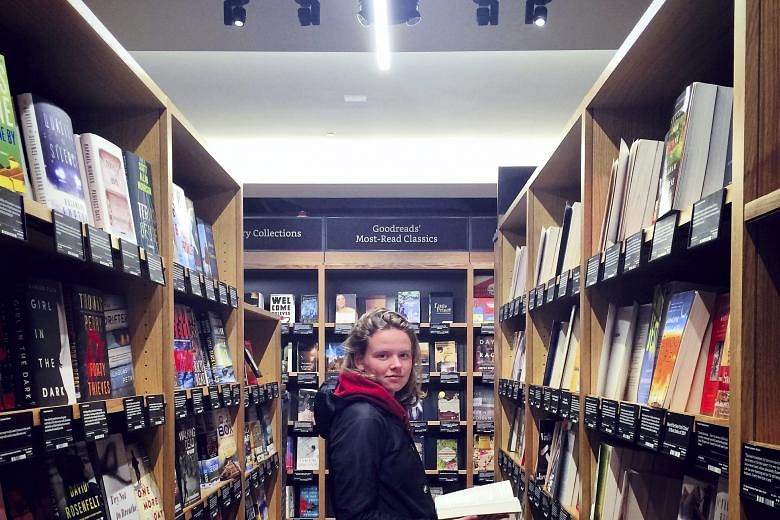NEW YORK • Last week, Amazon revealed the location of its second brick-and-mortar bookstore, which will open in a few months in Southern California, at a mall near the University of California in San Diego. The online retailer seems to have big ambitions for its physical stores.
Mr Nick Wingfield, who covers Amazon for The New York Times, visited the only Amazon bookstore in existence, in the University Village mall in Seattle. From inside the store, he had an online chat with Ms Alexandra Alter, who writes about publishing for The Times. They discussed Amazon's strategy and how the retailer's stores differ from other bookstores.
Alexandra Alter: Hi, Nick. You're reporting live from the mothership. What's it like?
Nick Wingfield: The best part is, I just tested the free Wi-Fi and it's 114 Mbps, easily the fastest I've gotten. Thank you, (founder and chief executive officer of Amazon.com) Jeff Bezos.
Alter: Great, so you can just buy stuff from the Amazon website while you're in the store. Unlike Barnes & Noble, I bet Amazon doesn't mind if people browse in its store, then buy it online.
Wingfield: Exactly. Here's the deal: At first glance, it looks like an ordinary but nice Barnes & Noble store. It's clean and well-lit and corporate. It doesn't have the charm of a funky used-book store. Once you start poking around the shelves, you notice the differences.
Alter: How is the selection different? How are the sections organised?
Wingfield: It has 5,000 to 6,000 book titles, fewer than what you would find at a big Barnes & Noble store. All of the books are arranged cover out, rather than spine out, in the belief that it makes browsing more friendly.
Alter: I see Amazon is going big on adult colouring books - smart move as those have taken over the bestseller list on the website. Can you check out something for me? I heard that the store has a shelf of books recommended by Jeff Bezos. Is his wife MacKenzie's novel there?
Wingfield: I'll go look now. Okay, I'm back. You were right. He recommends his wife's book.
Alter: What else is he recommending? Wingfield: Kazuo Ishiguro's The Remains Of The Day and Seveneves by science-fiction writer Neal Stephenson.
Alter: Here's another thing I'm curious about. A lot of people in the publishing industry were worried when they heard Amazon planned to open bookstores, in part because they assumed Amazon would heavily promote books published through its own imprints.
Amazon has had trouble getting those books into brick-and-mortar bookstores, which don't want to sell books by its No. 1 competitor.
But I've heard that the Amazon bookstore doesn't carry many Amazon Publishing titles.
Wingfield: I just asked a store employee and was told there's no dedicated section for Amazon- published titles, although some of them are sprinkled around the store.
Alter: Here's my biggest question about the bookstore. Amazon already has a huge market share of physical book sales through its website - 60 per cent - by some estimates. So why does it need physical stores?
Wingfield: Amazon, officially, won't tell you much about the motivations for its brick-and-mortar stores.
But what I gather from my reporting is it has a lot of ideas about how physical retailing can be improved, ideas that come from its data-centric approach to online retailing.
There is also a serendipity to book-shopping offline that's hard to replicate online.
Electronics, most of them made by Amazon - such as Echo and Fire TV - are the nucleus of the store.
They're spread out on tables and stands so you can fiddle with them just like you can fiddle with iPads at the Apple Store a short hop from here.
Knowledgeable people tell me that Amazon views its physical stores as an important way to introduce the public to new, unfamiliar devices.
Techies might be comfortable buying a device such as the Echo online - a speaker and virtual assistant for the home - but a lot of people will want to physically see it first.
That said, I don't think Amazon stores would have saved the Fire Phone - the Amazon smartphone that belly-flopped.
I should also say books are not necessarily going to be the focus of all of the stores it opens in the future. Amazon intends to experiment.
Alter: What else do you think it might sell in physical stores?
Clothing? Pets? This is a company that delivers groceries and paper towels, makes award-winning television shows and wants to send tourists into space, so the possibilities seem pretty vast.
Wingfield: I've heard food is one of the things it is considering.
Alter: Nick, sorry to send you on another scavenger hunt, but can you check to see if Brad Stone's The Everything Store: Jeff Bezos And The Age Of Amazon is on the shelves?
MacKenzie Bezos didn't like the book. She blasted it in a one-star review on Amazon.
Wingfield: I just found it. It was out of sight on a bottom shelf.
NEW YORK TIMES

